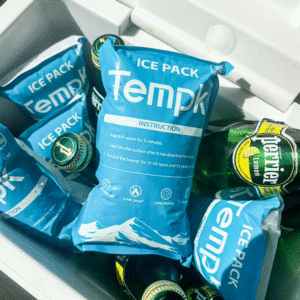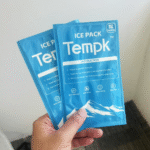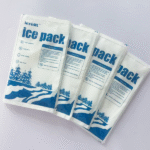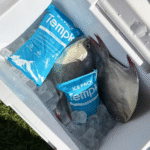Como embalar gelo seco no refrigerador com segurança em 2025
Se você está pesquisando como embalar gelo seco no refrigerador, aqui está a resposta rápida: use a dry‑ice‑compatible hard cooler, lugar blocks on top of items with a cardboard barrier, ventile o refrigerador, and size ice by trip length. Dry ice sits near −109 °F (-78,5 ° C.); the airline limit remains 2.5 kg (5.5 Libra) por passageiro em 2025.
-
How to pack dry ice in cooler for max hold time and safe venting
-
How much dry ice for a 50‑quart cooler (blocos vs.. Pellets)
-
How to pack dry ice in cooler for flights and couriers (2025 regras)
-
Whether you should mix dry ice and regular ice, e como
-
How to pack dry ice in cooler for outages, camping, and road trips
How to pack dry ice in cooler safely—what actually works?
Resposta curta: Put dry ice on top with a cardboard or rack barrier, keep the cooler vented, and pack tightly to remove air gaps. Os blocos duram mais do que os pellets, and pre‑chilling the cooler saves hours of hold time. Use insulated gloves and avoid airtight seals to prevent CO₂ pressure buildup.
Why this setup wins: Dissipadores de CO₂ frio, so top placement “washes” the load in freezing air. A barrier prevents freezer burn and protects plastic liners. Tight packing reduces convection that burns through ice. In field tests, properly packed 50‑qt rotomolded coolers kept contents frozen for ~40–52 hours in summer conditions when opened sparingly.
How much dry ice for 50‑quart cooler?
Usar 10–15 lb per 25 quantidade por 24 h for frozen performance; ~ 5-10 lb. para refrigerado. For a 50‑qt family cooler, plano 20–30 lb per day frozen and add 20–30% buffer for heat or frequent lid opens. Blocos > Pellets para longevidade.
| Planning target | 24 h (congelado) | 48 h (congelado) | O que isso significa para você |
|---|---|---|---|
| 25‑qt cooler | 10–15 lb. | 20–25 libras | Overnight deep‑freeze |
| 50‑qt cooler | 20–30 libras | 40–50 libras | Viagem de fim de semana, minimal lid opens |
| 75–100 qt | 30–40 lb. | 60–80 lb. | Multiday hunts or bulk prep |
Pro tips that extend hold time
-
Pré -Chill the cooler 12–24 h; dump meltwater before packing.
-
Preencher vazios with paper/towels; less air = slower sublimation.
-
Two‑cooler strategy: one “frozen,” one “day‑use” to cut openings.
Caso real: Um cooler rotomoldado de 50 qt com 25 Libra of blocks, cardboard base, and few openings held ≤10 °F for ~40 h, subindo para 28 °F by ~52 h in 92 °F ambient.
How to pack dry ice in cooler for flights and couriers (2025 regras)?
Resposta direta: Cap at 2.5 kg (5.5 Libra) por passageiro/pacote, Use embalagem ventilada, and mark “Dry ice / Dióxido de carbono, solid” with net mass. Airlines require approval; couriers require UN1845 marking and non‑airtight designs. Mantenha gelo seco separated from food by a barrier and secure the load.
O que fazer: Choose a small ventable hard cooler, coloque gelo seco no topo, adicionar uma barreira, and avoid gasket‑tight seals. For ground shipping, design vent paths and show NET KG no rótulo; para viagens aéreas, confirm airline approval on your reservation. These requirements remain current in 2025.
Can you fly with dry ice 2.5 kg?
Sim-≤2,5 kg per passenger in carry‑on or checked bags, com aprovação da companhia aérea, ventilação, and proper marking. If you need more cold mass, split into multiple compliant packages or combine with PCMs for non‑frozen lanes.
| Travel step | Faça isso | Por que isso importa | Para você |
|---|---|---|---|
| Quantidade | Keep ≤2.5 kg per person | Meets FAA/IATA baseline | Avoids check‑in refusals |
| Ventilação | Crack lid or drain plug | Prevents CO₂ pressure | Safety for cabin/hold |
| Marcação | “Gelo seco / Un1845 ” + NET KG | Required for handlers | Aceitação mais rápida |
| Colocação | Blocos no topo + barreira | Even freezing, protects liners | Maior tempo de espera |
How to pack dry ice in cooler with regular ice—does mixing help?
Sim. Place dry ice below with a separator, then regular ice above to fill gaps. The dry ice keeps water ice solid longer while protecting items that should stay cold, not rock‑hard. Colocar drinks farthest from dry ice para evitar congelamento; pack firmly to prevent flash‑freeze of produce.
Prevent freezing drinks with “zone packing”
Build zones: frozen zone nearest dry ice, buffer at mid‑height, e chilled zone for beverages far from the dry ice. Baskets or racks keep sensitive items off the cold deck. This lets one cooler serve both frozen and chilled needs without sacrificing safety.
How to pack dry ice in cooler for outages and road trips?
Sort items first. Freeze hard anything that must stay frozen. Pre‑chill the cooler, then layer cardboard base → payload → barrier → blocks on top. Vent slightly during driving and avoid sealed cabins; quebrar janelas para evitar o acúmulo de CO₂. Use a probe thermometer and keep chilled foods ≤40 ° F..
Car ventilation and safety
Do not trap a venting cooler in a sealed trunk or tent. CO₂ é inodoro e desloca o oxigênio. Transport in a ventilated area and store coolers out of small rooms. Luvas isoladas are mandatory; frostbite happens fast at dry‑ice temperatures.
2025 gelo seco & cold chain trends—what’s changing?
Instantâneo da tendência: CO₂ supply tightness makes early procurement wise in peak seasons, enquanto reusable shippers and PCM packs are expanding for 2–8 °C and −20 °C lanes. Dry ice remains the top choice for congelado e ultracold usar, but smart routing, Isolamento VIP, and monitoring reduce required pounds per trip.
Último progresso em um olhar
-
Air travel rules unchanged: 2.5 kg limit per passenger/package with venting and clear marking.
-
Blocks over pellets: longer hold time for coolers; Pellets para puxar rapidamente.
-
Two‑cooler strategy: fewer openings = less sublimation and better user safety.
Insight de mercado: Expect regional price and availability swings; plan re‑ice points on long routes. For many chilled deliveries, high‑performance PCMs cut cost and simplify compliance when −78.5 °C is not required.
Perguntas frequentes
Q1: What’s the single best practice for how to pack dry ice in cooler?
Colocar blocks on top with a cardboard barrier, ventile o refrigerador, e fill air gaps. This balances freezing power with safety.
Q2: Quanto tempo demora 10 lb of dry ice last in a 25‑qt cooler?
Sobre 24 horas under normal use; hotter weather or frequent openings shorten this. Add a 20–30% buffer.
Q3: Will dry ice crack my cooler?
It can if the model isn’t rated. Atenha-se rotomolded hard coolers approved for dry ice and use a barrier to protect liners.
Q4: Is it safe to mix dry ice and regular ice?
Yes—separate them with cardboard. Dry ice keeps water ice solid longer while protecting items you don’t want frozen.
Q5: Can I ship food with dry ice?
Sim. Use embalagem ventilada, marca UN1845 com NET KG, and place dry ice no topo of the payload inside the shipper.
Resumo & Recomendações
Pontos -chave: To master how to pack dry ice in cooler, usar blocks on top + barreira, ventile o refrigerador, and size ice using 10–15 lb per 25‑qt per day for frozen goals. Pre‑chill everything and reduce lid opens. Para voos, siga o 2.5 kg rule and required markings.
Plano de ação:
-
Confirm your cooler is dry‑ice compatible.
-
Use the estimator below to size your order.
-
Pacote base → payload → barrier → blocks and vent slightly.
-
Monitor temperature and plan re‑ice points.
CTA: Want a tailored pack plan? Book a free 15‑minute consult with Tempk.
Sobre Tempk
We design practical, compliant packouts for food, biofarmacêutica, e produtos especiais. Our calculators and playbooks reflect current FAA/IATA/PHMSA rules and brand‑specific cooler guidance, validated with field tests. The goal: menos surpresas, tempos de espera mais longos, and simpler compliance.
Próximo passo: Talk to our cold‑chain team for a free packout review.
























